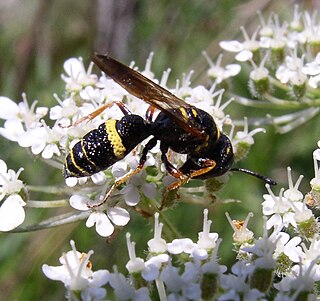Related Research Articles

Lepomis is a genus of freshwater fish in the sunfish family, Centrarchidae, in the order Perciformes. Perhaps the most recognizable species of this genus is the bluegill.

The pumpkinseed is a North American Freshwater fish of the sunfish family (Centrarchidae) of order Perciformes. It is also referred to as pond perch, common sunfish, punkie, sunfish, sunny, and kivver.

Beewolves, also known as bee-hunters or bee-killer wasps, are solitary, predatory wasps, most of which prey on bees, hence their common name. The adult females dig tunnels in the ground for nesting, while the territorial males mark twigs and other objects with pheromones to claim the territory from competing males.

The humpback cat shark is a cat shark of the family Scyliorhinidae in the order Carcharhiniformes, found in the northwest Pacific Ocean off Zhujiang, South China Sea, from the surface to 915 m. Its length is 39–41 cm. The largest specimen examined by Nakaya and Sato was 54.2 cm TL. The humpback catshark is a little-known oviparous deepwater catshark.

The cape rain frog or giant rain frog is a species of frog in the family Brevicipitidae. Adults grow up to 45 mm in length. It was the first African frog species to be scientifically described by Carl Linnaeus in 1758, under the name Rana gibbosa. It is the most common and largest of rain frogs.

Philanthus gibbosus, which is commonly referred to as a beewolf due to its predation practices, is a species of bee-hunting wasp and is the most common and widespread member of the genus in North America. P. gibbosus is of the order Hymenoptera and the genus Philanthus. It is native to the Midwestern United States and the western Appalachians. P. gibbosus are often observed to visit flowers and other plants in search of insect prey to feed their young. The prey that P. gibbosus catches is then coated in a layer of pollen and fed to the young wasps.

Tetrosomus gibbosus, commonly called camel cowfish because of the hump on its dorsal keel, is one of 22 species in the boxfish family, Ostraciidae. It is a ray finned fish. Other common names include helmet cowfish, humpback turretfish and thornbacked boxfish. It is most closely related to Tetrosomus reipublicae, the smallspine turretfish. T. gibbosus is a species of boxfish native to the Indo-West Pacific, but it has been established in the Mediterranean Sea via Lessepsian migration. It is mainly found at depths of 37–110 m (121–361 ft) on slopes or over muddy bottoms, but can sometimes be seen near shallow seagrass beds. Like other boxfish species, its flesh is poisonous. It feeds on a wide variety of invertebrates and algae.

Meadowridge Common is an 8-hectare (20-acre) reserve in the Meadowridge suburb of Cape Town, South Africa, which preserves a fragment of critically endangered Cape Flats Sand Fynbos vegetation.

Onciderini is a tribe of longhorn beetles of the subfamily Lamiinae, they are prevalent across Europe in nations such as Turkey, and Finland.

Trachysomus is a genus of longhorn beetles of the subfamily Lamiinae, containing the following species:

Plectorhinchus gibbosus, commonly known as the Harry hotlips, black sweetlips, brown sweetlips, dusky sweetlips, gibbous sweetlips, hairy hotlips or humpback sweetlips, is a species of marine ray-finned fish, a sweetlips belonging to the subfamily Plectorhinchinae, one of two subfamilies in the family Haemulidae, the grunts. It is native to the Western Pacific and Indian Oceans.
Trachysomus apipunga is a species of beetle in the family Cerambycidae. It was described by Martins and Galileo in 2008. It is known from Bolivia.
Trachysomus arriagadai is a species of beetle in the family Cerambycidae. It was described by Galileo and Martins in 1991. It is known from Argentina, Brazil and Paraguay.
Trachysomus buquetii is a species of beetle in the family Cerambycidae. It was described by James Thomson in 1858. It is known from Argentina and Brazil.
Trachysomus camelus is a species of beetle in the family Cerambycidae. It was described by Buquet in 1852. It is known from Brazil and French Guiana.
Trachysomus cavigibba is a species of beetle in the family Cerambycidae. It is known to inhabit Bolivia.
Trachysomus hydaspes is a species of beetle in the family Cerambycidae. It was described by Dillon and Dillon in 1946. It is known from Guyana and French Guiana.
Trachysomus luederwaldti is a species of beetle in the family Cerambycidae. It was described by Martins in 1975. It is known from Brazil.
Trachysomus santarensis is a species of beetle in the family Cerambycidae. It was described by Henry Walter Bates in 1865. It is known from French Guiana and Brazil.
Trachysomus wappesi is a species of beetle in the family Cerambycidae. It was described by Martins and Galileo in 2009. It is known from Trinidad and Tobago.
References
- ↑ BioLib.cz - Trachysomus gibbosus. Retrieved on 8 September 2014.